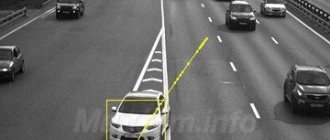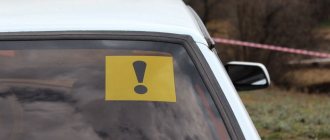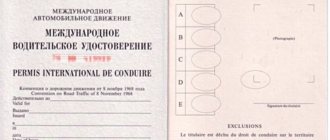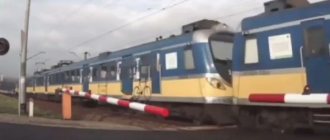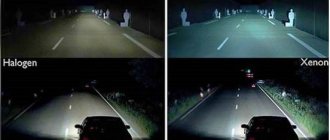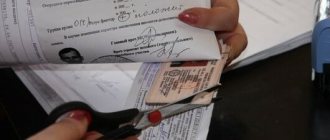Perhaps every car enthusiast is familiar with a blue sign in a red circle with intersecting lines. The stop sign is prohibited - one of the most important in the traffic rules system. The driver must comply with the instructions indicated by the sign, otherwise he will face a fine, the amount of which starts from 500 rubles. The editors of the publication “AvtoFemida” decided to explain all the subtleties associated with the interpretation of the sign prohibiting stopping. Read the following article and you will find out the exact coverage area of the stop sign.
No stopping sign: description
What does the “No Stopping” sign look like? On a blue background there is a red circle with intersecting lines in the form of a St. Andrew's cross of a similar color. There is no way to stop the car in its coverage area; there can be no exceptions.
In the area where the sign is valid, stopping is prohibited; there is no way to stop the car; there can be no exceptions.
In order not to get into trouble, you need to clearly understand on which stretch of our roads this sign is generally valid. So, the coverage area of the “No Stopping” sign begins directly from the place where it is installed. The driver has the right (without entering into conflict with traffic rules) to interrupt traffic no earlier than passing the intersection. The driver will be able to breathe a sigh of relief even after the “End of all restrictions” sign, the name of which speaks for itself, and after leaving the settlement territory.
Be careful! If you see, the effect of the sign will be different from the standard version, when a plate is attached below. This sign is intended to clarify the coverage area. Let's tell you in more detail. If you see an arrow pointing to the ground, then the sign itself serves as a travel restrictor. If you come across a sign with two arrows (one up, one down), then know that you are now in a section where there is a parking ban. What if you see a number on the sign? It's even easier to figure it out here. The number just sets the sign’s coverage area. If there is 2 km, then the coverage area is two kilometers. It's not at all difficult to remember. By the way, if the distance is specified in advance, then the “End of all restrictions” may not exist. Indeed, why put it when everything is already clear.
There is an option with a right (or left) arrow. There is nothing complicated here either. Where the arrow goes, there are restrictions. Let's say a few words about road markings. According to traffic regulations, a “No Stopping” sign without additional arrows implies markings. It should look like a uniform yellow line. The end of the marking also means the end of the sign's validity. An important nuance is on which side of the “Stopping is prohibited”, that’s why it works.
External description
Let's take a closer look at this security technology.
First, let's look at what it looks like externally. Imagine a red circle, which is filled with blue inside so that only the red rim remains. In the center of the circle is the intersection of two solid red lines. If there is still an arrow pointing down, then this is a clarification that the limiter operates from the place where the technical device is installed. In other words, the parking restriction zone is ending. If the arrow is pointing upward and the footage is still indicated, then you cannot stop the car throughout the entire distance indicated on the plate. If there is a sign under the vehicle with an arrow pointing in both directions, this means that the motorist is within the range of the parking restrictor.
Additionally, we recommend reading our expert’s article, which talks about the “Parking for the Disabled” sign.
Also, near objects of historical value, additional signs may be located under the sign, with horizontal arrows indicating the number of meters.
The numbers from the arrows on the prohibition sign are located at a greater distance - this feature will allow you to distinguish this technical safety device from others.
Sometimes a sign restricts parking at certain times. If so, then such information is indicated on the sign. If there is no information, then the time limit does not apply.
Sign 3.27 Stopping prohibited
The effect of this sign does not apply to route vehicles and vehicles used as passenger taxis in places where route vehicles stop or where vehicles used as passenger taxis are parked, marked with markings 1.17 and (or) signs 5.16 - 5.18, respectively.
The effect of the stop prohibited sign does not apply to route vehicles and vehicles used as passenger taxis
Sign area:
- from the installation site to the nearest intersection, and in a populated area, if there is no intersection, to the end of the populated area. Applies only to the side of the road on which they are installed;
- until the repeated sign 3.27 “Stopping is prohibited” from tab. 8.2.2, 8.2.3 “Coverage area”. At the same time, do not forget, tab. 8.2.3 indicates the end of the sign's coverage area. Immediately after the sign, stopping is permitted;
- determined by marking 1.4 yellow;
- to sign 3.31 “End of all restrictions zone”;
- at the end of their coverage area, repeated signs 3.27 - 3.30 with plate 8.2.3 or using plate 8.2.2.
Punishment for violating the requirements of the sign - Code of Administrative Offenses of the Russian Federation 12.19, part 1 and 5 other violations of the rules for stopping or parking vehicles. Warning or fine 300 rubles. For Moscow and St. Petersburg - 2500 rubles.
Sign 3.29 “Parking is prohibited on odd days of the month”
Road sign 3.29 “Parking is prohibited on odd days of the month” is used to prohibit parking on odd days of the month. Sign 3.29 is installed on the side of the road on which the prohibition is introduced.
Stopping in the area covered by the “No parking on odd days of the month” sign is not prohibited.
Sign 3.29 does not apply to:
- for vehicles driven by disabled people, transporting disabled people, including disabled children, if the identification sign “Disabled” is installed on these vehicles;
- on vehicles of federal postal organizations with a white diagonal stripe on a blue background;
- by taxi with the taximeter on.
The coverage area of the “Parking prohibited on odd days of the month” sign is discussed below.
No stop sign
The road sign has a round shape, a blue background with a red border around the circumference and red stripes intersecting at an angle of 90 degrees - a kind of cross. Thanks to this coloring (valid since 2013), the sign is clearly visible even from afar.
In places indicated by this sign, not only stopping, but also parking (or parking) of vehicles is prohibited. In this case, a forced stop or parking is possible if the vehicle breaks down or the driver feels unwell, as well as for other similar reasons.
In this case, the driver must turn on the hazard warning lights. You will also need to post an emergency stop sign on the road. If all these conditions are met, traffic police officers will not record a violation. An exception is also provided for stopping route vehicles. These categories of road users are allowed to stop in places specially designated for them to stop, but not in front of them.
The road sign has a round shape, a blue background with a red border around the circumference and red stripes intersecting at an angle of 90 degrees, a kind of cross
At the same time, there is no provision for imposing a fine for stopping cars driven by disabled people if the sign is supplemented with the appropriate plate (8.18) - a wheelchair is graphically displayed, crossed out with a red line.
Also, the driver should not pay attention to the installed road sign prohibiting stopping if a representative of the traffic police slows him down - this will not constitute a violation. So, he is obliged to stop at the place indicated to him by the traffic policeman or traffic police inspector.
For violation of traffic rules in the part relating to the prohibition of stopping, the Code of Administrative Offenses provides for a fine and detention of the vehicle or a warning (Articles 12.19 and 12.16). The 2013 edition of these articles increased the fine.
Fine 500 rub. (since 2013) and issuing a warning to the driver are provided for in Article 12.19 if he has committed a violation of the rules of stopping and parking (first part), 2 thousand rubles. plus detention of vehicles if such a violation created obstacles to traffic (part 4). Article 12.16 was also amended in 2013 regarding fines, which are still in effect today. Part one of this article provides for a fine of 500 rubles. or warning for violation.
Appealing a fine and towing a car for stopping under a “No Stopping” sign
There are situations where a fine is imposed incorrectly, and in such cases the most reasonable approach would be to appeal it. This is possible in a general manner; you need to act in exactly the same way as when challenging any other penalties from the traffic police. And just as in other cases, no undesirable result will follow even if the sanctions are not lifted. So in doubtful cases you can safely write them. You just need to meet the 10-day deadline from the date of imposition, otherwise you will have to seek a return to the deadline, which is only possible if there is a good reason (24.5 of the Administrative Code).
The complaint can be sent directly to the traffic police or to the court. Experts recommend going straight to court, since the traffic police department has a rate of cancellation of penalties that is not too high. However, you will have to wait up to 2 months for the result from this authority, while for the traffic police this period is no more than 10 days. It is necessary to send the application by letter, attaching all the evidence that can reliably confirm your case.
When writing a complaint, you must indicate the body to which you decided to send it, and also state the essence of the incident. At the same time, it is important to indicate weighty arguments and evidence of your correctness and the illegality of the penalties issued. This is extremely important, since the application will not be considered without compelling circumstances.
After writing a complaint, send it by letter and wait for the result. It will also come by mail. This will either be a refusal if the grounds are not considered compelling, or a confirmation that will eliminate the need to pay a fine.
Having a new resolution in hand that cancels the previous one, you can even get the fine returned if you still decide to pay it so as not to waste time. Some people in any situation tend to pay in advance in order to meet the 20 days that provide a discount. After all, sometimes it is difficult to say in advance whether an appeal against a decision will be denied, or whether it will be revised in the interests of the petitioner.
And even if you are not going to use the received resolution in any way, it must be saved for at least a year or two in order to avoid various troubles. So, it happens that they forget to remove a person from the list of fines, in which case paper will be necessary. Also, when paying a fine, if you decide to pay it in advance, you need to keep the receipt, otherwise it will be difficult to return the funds. In general, it is better to save documents and receipts and keep them for 2 years - after all, this is the period that determines the limitation period for administrative offenses.
In general, the cancellation of this fine is most often achieved if the situation was recorded on camera, and the driver actually had valid reasons for making the stop. In such cases, proof of the existence of these very reasons is required. And sometimes there are difficulties with this, since sanctions from cameras come late. Don’t forget to turn on the side lights when you stop the vehicle due to a breakdown, then there will be much fewer problems.
Sometimes traffic police officers who do not want to understand the situation in detail also impose unlawful penalties. Challenging helps in these cases too. In addition, fines can be refuted if the protocol was incorrectly drawn up, procedural errors, or if the statute of limitations has expired. All this is quite possible if you act wisely. Many motorists successfully seek the cancellation of unlawful penalties by taking the evidence base seriously.
Area of operation of the stop sign is prohibited
An urgent problem in qualifying the “No Stopping” sign is determining its coverage area. This seems to be very important also because the driver can stop and park not in those places where they are permitted, but in those where they are not prohibited.
The “No Stopping” sign begins its operation at the place where it is installed and prohibits stopping and parking until:
- the nearest intersection in the direction of travel;
- the end of the settlement;
- Places where road sign 3.31 “End of all restrictions zone” is installed.
These road sections embody the general principles of limiting the coverage area of a number of prohibitory signs, which include the “No Stopping” sign. That is, after passing the specified sections of the road, the sign ceases to be in effect, and stopping and parking are allowed again.
The coverage area of the “No Stopping” sign can also be indicated (or limited) using signs.
The coverage area of the No Stopping sign can be indicated or limited using signs
Table 8.2.2, installed with a sign, regulates the distance at which the prohibition of stopping and parking will apply. In other words, stopping and parking will be allowed after traveling the distance indicated on the sign.
Table 8.2.3 in combination with the sign indicates the end of its coverage area. Simply put, the “down” arrow on the sign means that the “No Stopping” sign acts as if in front of the place where it is installed - from the sign and back).
Table 8.2.4. will indicate to the driver that he is currently in the area covered by the “No Stopping” sign. The sign is used to additionally indicate the current restriction on those sections of roads where a regime of prohibited stopping and parking was previously introduced. And this regime has not yet been canceled.
It is important to note that the “No Stopping” sign is only valid on the side of the road on which it is installed.
Plates 8.2.5 and 8.2.6 (together or separately), installed with the “Stopping Prohibited” sign, are used to limit stopping and parking along squares, building facades, etc. Stopping and parking will be prohibited from the place where the sign is installed in the direction of the arrow on distance indicated on the plate.
The current problem of qualifying the No Stopping sign is determining its coverage area
The sign's coverage area can also be reduced by installing information sign 6.4 “Parking (parking space)” and plate 8.2.1, together indicating the permitted parking place for the vehicle.
The rules also require the combined use of the “No Stopping” sign with a yellow solid marking line (1.4), which is applied to the edge of the roadway, on top of the curb or on the edge of the sidewalk bordering the roadway. In this case, marking 1.4, prohibiting stopping and parking, determines by its length the coverage area of the “Stopping is prohibited” sign. Thus, the effect of the sign ceases after the section of the road with the yellow solid marking line ends.
This provision is very relevant for drivers looking for a parking space in an urban environment. The fact is that, according to traffic rules, in populated areas sometimes (subject to a number of conditions) stopping and parking is allowed on the left side of the road. A sign prohibiting stopping and parking on the right side of the road does not exclude the possibility of parking on its left side. Finally, it must be remembered that sign 3.27 “Stopping is prohibited” does not apply to route vehicles.
Temporary ban on stopping and parking in certain places
Also, according to the current legislation and traffic rules of the Russian Federation, local authorities have the right to temporarily limit the stopping and parking of vehicles on certain sections of the road (for example, during public events: festivals, rallies, etc.) or for road work. To this end, authorities are required to place temporary road signs in such places, strictly observing the current Traffic Rules. Let us remind you that the traffic rules have temporary road signs that look the same as the main ones, but have a yellow background.
Accordingly, if you violate the instructions of temporary road signs (for example, “No Stopping” or “No Parking”), you may be subject to the same penalties as for violating main road signs.
No stopping sign
This road symbol can be found very often - a blue circle with a red border, crossed diagonally by one red stripe. It is clear that it prohibits parking of vehicles on any day of the week.
But sometimes you can find it prohibiting parking, for example, only on odd days, or even days - on them one or two white stripes (vertical) are drawn inside a crossed out circle. Accordingly, one lane is crossed out - you cannot park a car only on odd days, two - on even days.
It is important not only to confidently imagine what prohibitory signs look like and what exactly they prohibit, but also to understand exactly on which sections of the roadway they operate, that is, to imagine the area of effect of the sign.
However, there are restrictions here too - the ban is valid only until the evening - until 19.00, so in order not to break the rules, before 21.00 the vehicle must be driven to the other side of the road - as a rule, a sign with a reverse restriction is installed on it. Well, in the period from 19.00 to 21.00 you can park your car in the coverage area of any sign - you will not break the rules. It should also be noted that there are categories of people who can safely ignore the “Parking Prohibited” symbol.
This road symbol can be found very often - a blue circle with a red border crossed out diagonally by one red stripe
We will not describe in detail the rules for federal postal vehicles, for which this type does not apply - this is not relevant for us. It is much more important that cars of disabled people of groups I and II and persons transporting such disabled people can park under this graphic element without fear.
No parking or stopping sign
This type, so to speak, is closely related to the road sign we described above. The fact is that where stopping is prohibited, parking is also prohibited, but not vice versa.
You can stop in a “No Parking” zone and you won’t be fined. Let's take a brief look at how a parking lot differs from a stop. There are no difficulties here, since this issue is covered in some detail in the traffic rules. Understanding the differences between parking and stopping is very simple.
Stopping means keeping the vehicle stationary for no more than five minutes; accordingly, if you stand longer, the actions will be classified as parking the vehicle.
The sign Parking and stopping is prohibited are closely interconnected
But if at the same time you perform actions related to boarding/disembarking passengers, loading/unloading a car, then regardless of how much time it takes you, you will make a stop, not a parking lot, even if it lasts at least 15 minutes, at least a whole hour. Externally, “Parking and stopping is prohibited” is very similar to the prohibitory type we described above, only it is no longer one diagonal red stripe on a blue background, but two intersecting stripes.
It also applies only to its own lane. Exceptions to which this symbol does not apply include only route vehicles. Please note that disabled people in their vehicles can no longer stop in the coverage area of this element, unless, of course, a corresponding information sign is installed under it.
How does a stop sign work?
The road sign “Stopping is prohibited” is designated in the Road Traffic Regulations as number 3.27 and indicates to the driver that it is forbidden to stop after it, and in some cases even before it. The sign is round in shape, on a blue background with a red border there are two red lines forming a cross. This design is noticeable from a distance and attracts the driver’s attention.
A sign prohibiting stopping is located on the ground on those sections of the road where stopping or parking a vehicle can create significant obstacles for other road users, for example, on a narrow section of the road, before a sharp turn, in areas with busy traffic.
The effect of the sign may be limited by time and day of the week; such information is usually indicated on an additional plate with a white background in black font and indicates that the driver should not stop at the specified time. The accompanying plate may also contain information about the vehicle for which stopping is prohibited. It is prohibited to park or stop under a “No Stopping” sign.
Under general conditions, the territory falling within the coverage area of a road sign extends to an intersection or the place where a populated area ends, as well as in the presence of a road sign that cancels all previously existing restrictions (3.31). Also, the sign's coverage area can be indicated using additional road signs. A sign with a black arrow going down on a white background (8.2.3) indicates that stopping before the sign is prohibited.
A sign with a black arrow going down on a white background 8.2.3 indicates that stopping before the sign is prohibited
In the case where under the “Stopping is prohibited” sign there is a sign with an arrow going up and indicating the distance, for example 500 meters (sign number 8.2.2), such a sign indicates the distance within which the vehicle cannot be stopped.
The effect of the sign begins from the place where it is installed. Stopping in front of a sign with this designation is not prohibited. A sign with a black double arrow pointing up and down on a white background reminds motorists that the ban on stopping a car is long-lasting and applies before and after the sign.
The presence of yellow markings in the form of a solid line (1.4) along the curb or edge of the road, in the area of the sign prohibiting stopping, indicates the coverage area of the sign. You should not stop vehicles at the indicated place; failure to respect the line boundary is equivalent to a fine.
When can you stop at a No Stopping sign?
Forced breakdown of the car or poor health of the driver. In such cases, stopping the vehicle in the area of the sign is possible. In case of such an unplanned stop, you must immediately turn on the hazard warning lights and display an emergency stop sign. By observing these conditions, you can avoid punishment for violating the sign requirements.
Route vehicles have the right to stop in specially designated places, but not in front of them. A car driven by a disabled person, if the “Stopping is prohibited” sign is added to the bottom with a corresponding sign with a wheelchair crossed out by a red line, has the right to stop in the area of the sign.
A forced stop of a vehicle near a sign prohibiting stopping is not considered a violation of the requirements of the sign also if:
- prohibiting traffic light signal;
- when asked by a traffic policeman or traffic police officer to stop;
- when standing in a traffic jam, congestion.
Prohibited parking and stopping areas
The legislation establishes and enshrines in the Traffic Rules road sections on which it is strictly forbidden to stop. This cannot be done not only because of the legal prohibition, but also because the action can be dangerous to the health and life of the driver and passengers.
An exhaustive list is indicated in clause 12.4 of the current traffic rules. These route segments include:
- Bridges, overpasses or overpasses that have one or two lanes for traffic in the same direction. If there are more than two lanes, the risk of an accident is reduced, as safe passage becomes possible.
- Tram tracks and railway crossings are also not intended for intentional vehicle stops.
- Stopping in tunnels is prohibited, regardless of the number of lanes. Also under bridges and overpasses, excluding specially designated under-overpass parking areas.
- It is not allowed to park on a section of the road if, after traffic stops, there remains a distance of less than 3 m between your car and the continuous marking line or the right edge of the roadway. If another car possibly passes your vehicle, it will be forced to drive onto the continuous marking line, violating the current traffic regulations.
- Road intersections. In addition to the intersections themselves, it is prohibited to park a car in an area closer than 5 m to the intersection.
- Marked pedestrian crossings. Stopping or parking on them is punishable by a fine. It is also prohibited to park the car closer than 5 m to them.
- On a section of the road designated for a bus stop. They have yellow road markings with a broken line. The landing area also includes 15 m before the stop and the same distance after it.
- On lanes dedicated to public transport and lanes for cyclists.
- It is not allowed to park a vehicle if its dimensions will obscure the visibility of road signs or traffic lights to other road users.
- It is not allowed to leave the vehicle on a section of the road with limited visibility, less than 100 m, when placing the vehicle on the roadway.
- According to traffic rules, you should not abandon your car when it becomes an obstacle for other vehicles to exit or turns into an obstacle for pedestrians.
Important! The parking ban includes parking or stopping a car on roads or highways.
In these cases, you can stop the car only in a designated place on a designated area. Only an unexpected stop on the side of the road or asphalt section of the road is allowed.
